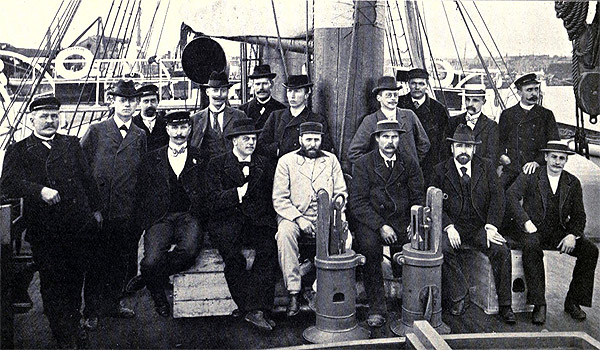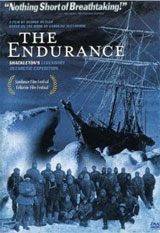|
|

|
||
 |
|
|||||
| Antarctica Picture | Antarctica Cruise | Facts | History | Boots | Store | Clothes | Whales | Books | Video | Schools | Forum | Site Map | FIDS / OAE's |
|
|
Fram - page 2Ships of the Polar Explorers |
"There were still many white spaces
on the map which I was glad of an opportunity of colouring with the
Norwegian colours" |
|
Antarctic Ships:
Overview
Historical:
L'Astrolabe & Zelee |
Aurora |
Belgica | Discovery
| Endurance Erebus / Terror: Ross-Antarctica Franklin-Arctic Franklin time-line Franklin-Map | Fram Fram 2 | Nimrod | Terra Nova Modern: Ice-strengthened and icebreakers | James Clark Ross | Kapitan Khlebnikov | Yamal |
Ships then and now - a comparison |

Norwegian Arctic Expedition (1898-1902) led by
Otto Sverdrup - center in light suit
|
The Ship Topsail Schooner / 1 funnel, 3 masts / L,B,D: 127.8' x 34' x 15'' - 39m x 11m x 4.8m / 402 tons / Hull: wooden / Compliment: 16 / Engine: steam triple expansion 220 hp, 1 screw, 7kts / Designed, Colin Archer. Built, Colin Archer, Larvik, Norway 1892 Also fitted with a windmill to power electric lights
Expeditions
The Fram was not a handsome ship when completed, the ends were blunt and looked almost identical, the rounded bottom to help escape from the ice did not make for graceful lines. All but 3 inches of the keel was hidden which would make her performance in heavy seas poor. But she was enormously strong, as Nansen put it "I arrived at the result that the strength must be several times that necessary to withstand the pressure required to lift her."
Fate after the expeditions: The Fram is preserved in Oslo (formerly Christiana) at the Fram museum
|
The Expeditions
Otto Sverdrup during his lifetime (1872 - 1928) was as famous an explorer as Nansen and Amundsen, though since then, he has been overshadowed by his compatriots. Sverdrup had previously crossed the Greenland icefield with Nansen in 1888, and like Nansen, this journey had made his name in polar exploration circles. He had been the commander of the Fram when Nansen and Johansen had left to strike out for the North Pole in 1895 staying with the ship until she was released at last (with help of some explosives) from the pack and returned to Norway with her. Two years after her return from being the ship to have reached the furthest North and being also the only one ever to purposefully freeze into drifting pack and then return intact (incidentally, with a fit and healthy crew too, a rare occurrence for Arctic expeditions at the time), the Fram set out again on an expedition led by Otto Sverdrup. The expedition was financed by Nansen's chief patron's Axel Heiberg and the Ringnes bothers, wealthy brewers. They had originally asked Nansen to lead the expedition, but by now Nansen felt he had had sufficient of Arctic exploration and the hardships involved and suggested that the offer to lead was made to Sverdrup. He was fortunate in that he was allowed a free hand in where to explore and so chose the unknown coast of Northern Greenland. He was also at liberty to change his objectives should it become prudent or advantageous to do so. On the 24th of June 1898, the Fram reconditioned by her builders set off on her second expedition of polar discovery. The Fram was to sail through the passage between the west coast of Greenland and Ellesmere Island. But as was often the case, heavy ice was against the ship and she was unable to make headway as it was too thick for her. The only predictable thing about Arctic pack is it's unpredictability. One year it may be possible to sail easily for tens or hundreds of miles, while the next year in the same area, virtually no progress at all may be made. Instead of being able to reach further north, the Fram anchored for four years in various fjords around Ellesmere Island acting as a base for exploratory sledging trips into the unexplored west and north. Attempts by the ship each spring at making passage northwards were constantly halted by pack conditions. There was plenty of "white spaces" here for Sverdrup and the other sixteen crew members to profitably explore however. Though less obviously impressive than the achievements of Nansen and Amundsen in the Fram, this journey accomplished a great deal. The expedition members sledged a total of some 18,000 kilometres, 700 nights were spent under canvas and a 200,000 square kilometre island group was surveyed - greater than the combined discoveries of numerous previous expeditions. These islands known as the Sverdrup Islands were annexed for Norway, though later became part of Canada, retaining the Norwegian names they had been given. Considerable scientific measurements and findings were made during this time too which added greatly to the knowledge at the time.
The Fram was brought out of retirement in 1910 by Roald Amundsen who wanted to emulate Nansen's attempt to drift over the pole in his 1893-1896 expedition. He wanted to put the ship in the ice once again in the Bering Sea and drift over the pole. Before the Fram even left Norway however, news arrived that the north pole had already been attained by the American Robert Peary on the 6th of April 1909. Amundsen changed his plans, but did not announce them to the crew until the Fram reached Madeira. Up to this point they were all under the impression that they would head north again for the Arctic. Also surprised by the change was Robert Scott and the British expedition that didn't find out about Amundsen's change of plan until the Norwegian's had actually arrived in Antarctica. This was in an era where explorers often informed each other of their plans and would stay away from a particular area if they knew there was another party there who would be considered to have "prior claim". It was not considered "gentlemanly" to compete directly or race. Unknown regions were a sort of arena where explorers would do their best and then triumph or retreat to allow others the space for their efforts. The Fram arrived in the Ross Sea area of Antarctica in January 1911. Amundsen established a winter station which he called Framheim, the attempt on the pole was to be made in the following spring by Amundsen himself and four companions. The story of Scott and Amundsen's south pole journeys are recounted elsewhere on this site. While the polar party had left, the crew explored the Antarctic Ocean somewhat in the Fram. In particular they made an attempt to sail as far south as possible, reaching 78°41'S and in the process becoming the ship that had sailed the furthest north and also the furthest south. The Fram had in all sailed some 54,000 nautical miles or the equivalent of two and a half times around the equator. The Fram arrived home in Norway in 1914 and was left for some time as the First World War took over in people's minds. By 1916 a committee had been established and began to work for the repair and preservation of the ship. Otto Sverdrup was particularly active in this and by 1935 the "Fram Museum" was been opened where the ship is preserved today. |
Cool Antarctica
Store - Pictures, Shirts, Calendars, Cards etc.

Lonely Planet travel guide Antarctica
![]() USA |
USA |
![]() UK
UK
![]() Free world delivery
Free world delivery

The Endurance
- Shackleton's Legendary Expedition
Dramatization with original footage
![]() DVD |
DVD |
![]() DVD
DVD

Custom Search
|
Home
| Site Map |
Pictures |
Antarctica
Stock Photos |
Facts |
History | Antarctica
Travel |
Antarctic Clothing |
Video |
Books |
Calendars |